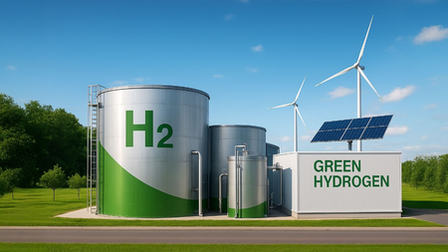
New Delhi — Green hydrogen is rapidly becoming a critical fuel for cutting emissions in hard-to-abate sectors such as steel, fertilisers, shipping, aviation, and transport — and India is uniquely placed to lead this global transition, according to an article by former G20 Sherpa and NITI Aayog CEO Amitabh Kant.
Published in India Narrative, Kant’s article highlights that while regions like Europe, Japan, Korea, and the Middle East are investing billions in renewable hydrogen, India possesses the ideal combination of resources, policy framework, and demand to emerge as the world’s foremost hub for green hydrogen.
He identifies five key strengths driving India’s advantage:
Low-cost renewable energy: India offers the world’s most competitive round-the-clock renewable power prices, ranging from ?4.60 to ?5 per kWh, making hydrogen production highly cost-efficient.
Robust policy support: The National Green Hydrogen Mission provides clear targets and regulatory certainty, boosting investor confidence.
Strong industrial ecosystem: With a well-developed base in engineering, pipelines, refineries, and ports, India is equipped to scale up hydrogen production and distribution.
Large domestic demand: High consumption across sectors such as fertilisers, refining, steel, and chemicals ensures steady local demand alongside export potential.
Global export opportunity: Markets like Europe and Japan are seeking clean hydrogen imports, positioning India as a strategic and competitive supplier.
The article also highlights the progress made under India’s green hydrogen initiative. The Solar Energy Corporation of India (SECI) has awarded contracts for 450,000 tonnes per annum of green hydrogen production to major players including Reliance, Greenko, ACME, and L&T. SECI has also finalised a 724,000-tonne green ammonia tender aggregating demand from 13 fertiliser plants, achieving a record-low price of ?55.75 per kilogram, among the most competitive globally.
Additionally, Indian Oil Corporation has launched a major green hydrogen project at its Panipat refinery, while Bharat Petroleum Corporation Limited (BPCL) has partnered with Singapore’s Sembcorp to develop green hydrogen and green ammonia projects domestically.
Kant acknowledges that challenges remain — such as high capital costs, certification standards, skill shortages, and tender delays — but argues these can be addressed through concessional and blended financing, international standard alignment, targeted skilling programmes, and improved project management.
“By producing the world’s cheapest green hydrogen, building value-added products like green steel, ammonia, and fertilisers, and becoming a trusted global supplier, India can position itself at the forefront of the clean economy,” the article concludes.
“The green hydrogen race is on — and while many nations are running hard, India has the potential to finish ahead.”
With inputs from IANS